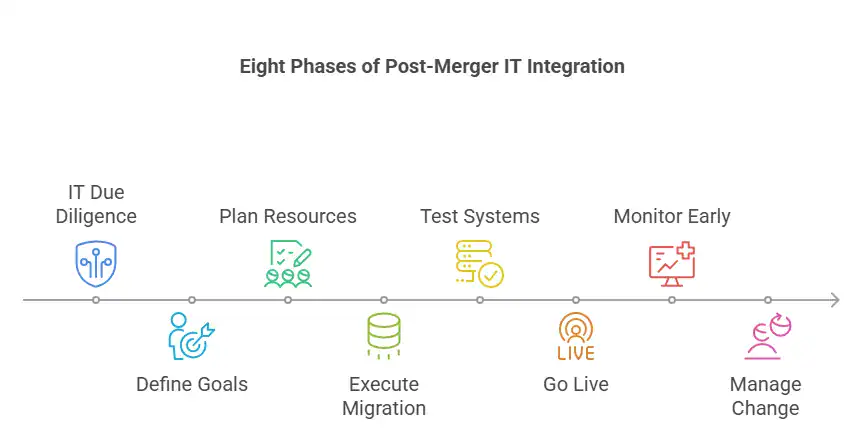Charlotte IT Firm Highlights Why Integration Matters in M&A Success
Charlotte, United States - August 29, 2025 / AT-NET Services - Managed IT Services Company Charlotte /
Charlotte IT Company on Why IT Integration in Mergers & Acquisitions Matters
Many mergers and acquisitions fall short, not because of strategy, but because IT systems remain fragmented.
According to McKinsey, 50–60% of synergy initiatives in M&A are strongly tied to IT, yet businesses overlook most technology issues during due diligence and early post-merger planning.
As Jeffrey S. King, President of AT-NET, says, “IT integration isn’t just a technical exercise. It’s the architecture of transformation. When done right, it accelerates processes.”
IT integration in M&A goes far beyond connecting servers. It involves:
- Migrating and cleansing large volumes of data without compromising accuracy
- Unifying processes so cross-functional teams can collaborate seamlessly
- Retaining key IT talent and equipping teams to navigate new systems
- Modernizing security controls to mitigate risk and ensure compliance
When executed with precision, IT integration preserves business continuity, strengthens customer trust, and enables faster response to market shifts. Without it, even the most promising deal can stall.
In this blog, our IT company in Charlotte uncovers the critical role of IT integration in mergers and acquisitions and shows how to turn integration into a competitive advantage.
Why IT Integration in Mergers and Acquisitions is Critical
IT integration is critical because it shapes what your merged company can achieve. Without connected systems, your teams work in silos, and mistakes happen.
Thoughtful IT integration processes during an M&A help to:
- Protect data (prevent downtime): Smooth integration avoids data mismatches, loss, or duplication. This keeps systems available, allowing employees to work without disruption and protecting revenue and customer trust.
- Speed up market entry (react faster): Integrated systems help your business offer new services quickly. This faster rollout allows you to win customers before competitors catch up.
- Support tools (manage complexity): Mergers and acquisitions software brings everything into one place. It reduces manual work, tracks progress, and lowers the chance of missing deadlines.
Each benefit contributes directly to business outcomes such as higher revenue, lower cost, and better compliance.
Planning the IT landscape in M&A projects
Planning prevents surprises later. Start by understanding what systems exist, what overlaps there are, and what gaps could cause problems.
- List everything (know your assets): Document every application, server, database, and cloud tool. Include unofficial “shadow IT” because it can hide real risks.
- Spot gaps (find disconnects): Look for data that can’t move easily, outdated applications, and processes that depend on a single person. Fixing these gaps before integration avoids disruption.
- Retire outdated systems (save costs): Identify tools you no longer need after the merger. Removing them reduces support effort and frees your budget.
Then, once you have a picture of the integration needs, set clear, measurable goals:
- Control costs (stay on track): Define how much you can spend. Use regular reviews to catch overruns early.
- Keep data secure (protect trust): Apply unified security policies to protect sensitive data, especially during transfers.
- Stay compliant (avoid penalties): Understand which regulations (like GDPR or HIPAA) apply. Document how your plan meets them.
Overcoming IT challenges in post-merger integration
Even the best plans face real-world challenges. By knowing what to expect ahead of time, you can better prepare to manage post-merger integration events.
- Keep talent (retain expertise): Your IT team knows how systems work, where risks hide, and what can break. Keeping them during integration avoids knowledge loss and keeps the timeline on track.
- Train teams (reduce friction): People need time to learn new tools and processes. Training programs reduce mistakes, boost confidence, and keep morale high.
- Balance systems (old vs. new): Older systems may hold critical data, but could slow down modern platforms. Phasing out legacy systems carefully keeps operations stable while making room for innovation.
- Prioritize steps (control risk): Focus first on systems critical to daily operations, then move to supporting tools. This staged approach avoids big disruptions.
- Communicate clearly (build trust): Regular updates keep staff engaged and reduce resistance to change. Clear messages help everyone see the purpose and value of integration.
How to Secure Systems During Integration
Security considerations are essential; they can’t wait until the end of the project. Integration exposes data and systems to new risks if you don’t plan early.
According to CloudSecureTech, 97% of applications tested contain at least one vulnerability. This shows why proactive planning matters.
- Follow standards (guide actions): Frameworks like ISO/IEC 27001 or NIS2 help you define policies and track them across teams.
- Limit access (reduce attack surface): Grant employees only the access they need. Fewer permissions lower the chance of mistakes or malicious actions.
- Encrypt data (protect transfers): Always encrypt data at rest and in transit. Even if attackers intercept data, encryption keeps it unreadable.
- Run audits (spot weaknesses): Regular reviews catch misconfigurations before attackers can exploit them. Fixing small issues early avoids large breaches.
The Eight Phases of Post-Merger IT Integration
Integration should never be a single “big bang.” It should occur in phases, over time, and with full support of everyone involved. A phased approach keeps it manageable and transparent.
- IT due diligence (map the landscape): Identify systems, processes, and risks before starting.
- Define goals (set the direction): Clear metrics keep the project focused and measurable.
- Plan resources (prepare teams): Assign dedicated staff, set timelines, and lock in your budget.
- Execute migration (move data safely): Transfer data and applications carefully to keep accuracy.
- Test systems (ensure reliability): Find and fix errors before employees rely on the new systems.
- Go live (train and support): Assist staff with guides, FAQs, and real-time support.
- Monitor early (hypercare): Watch for unexpected problems and fix them quickly to help them adapt and avoid bigger issues.
- Manage change (keep momentum): Communicate updates, successes, and lessons learned to maintain team motivation.

The Role of Mergers and Acquisitions Software
Successful M&A integration demands more than spreadsheets. It requires precision, visibility, and control.
As organizations juggle data migration, compliance, and team alignment, the right software transforms complexity into clarity.
With enterprise application integration projected to grow from $17.67 billion in 2025 to $36.56 billion by 2030, it’s clear that digital tools are becoming essential for scalable, secure integration.
Here’s how modern M&A software supports that transformation:
- Automate tasks (avoid errors): Automating data migration reduces manual mistakes and speeds up integration.
- Track progress (stay aligned): Dashboards and real-time reports help managers see where the project stands and address delays quickly.
- Meet regulations (prove compliance): Built-in audit logs and reporting make it easier to show regulators that you meet data privacy and security requirements.
Comparing Integration Models: In-house, Hybrid, and Fully Managed
When planning integration, you should decide if work stays internal, is partially outsourced, or is fully managed.
Here’s a quick comparison to guide decisions:
| Model | Pros | Cos |
| In-house | Greater control; team learns new skills | Higher cost, slower execution, and talent retention |
| Hybrid | Balance of expertise and control | Requires coordination between teams and vendors |
| Fully managed | Fast execution; access to experts | Less direct control; higher vendor dependency |
Take the Smarter Path to IT Integration With a Leading IT Company in Charlotte
IT integration in mergers and acquisitions determines how quickly you realize the full value of a deal. This includes protecting critical data, setting realistic timelines, and keeping your teams supported through change.
Careful planning and tools such as mergers and acquisitions software help keep every part of the project aligned with your business goals.
AT-NET brings deep expertise, backed by over 300 industry certifications from partners like Microsoft, Cisco, and VMware, and a guaranteed 99.999% uptime to minimize business disruption.
Contact our IT firm in Charlotte today to discover how we can assist you in planning and delivering successful IT integration projects that keep your operations secure and competitive.

Contact Information:
AT-NET Services - Managed IT Services Company Charlotte
3401 St Vardell Ln Suite D
Charlotte, NC 28217
United States
Joel Sosebee
(844) 506-2116
https://www.expertip.net/
Original Source: https://expertip.net/it-integration-in-mergers-and-acquisitions/

